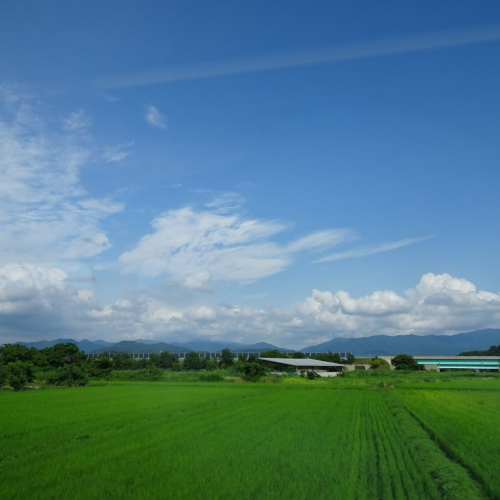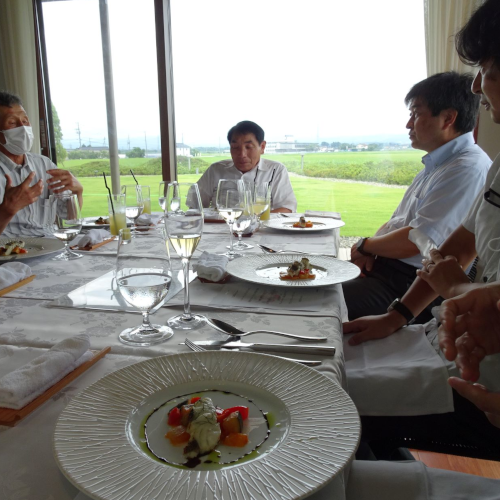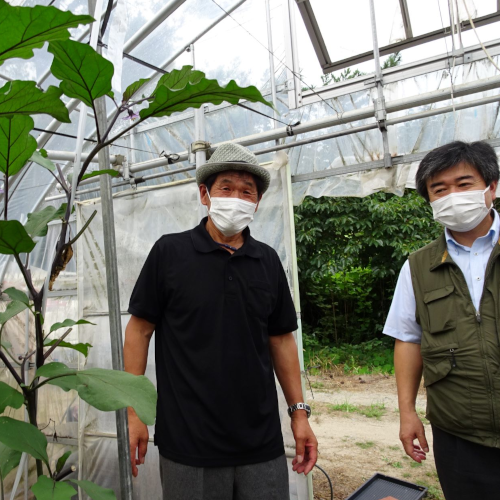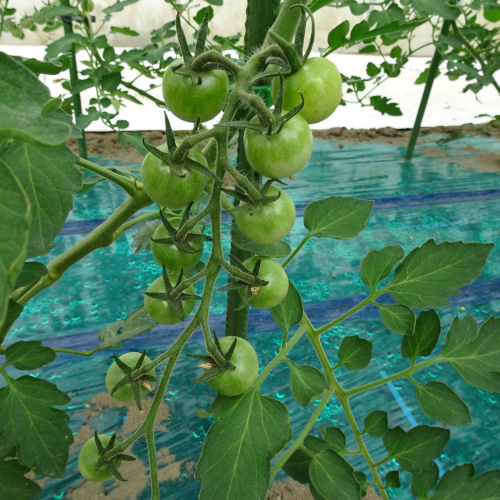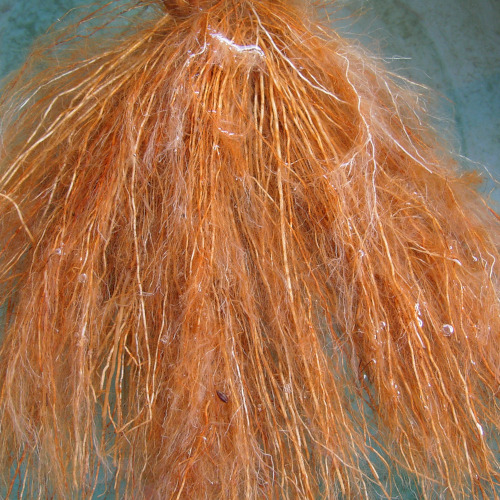青森のりんご農家を訪ねて
弘前市、鯵ヶ沢町、三戸郡のりんご農家を訪ねて
「一日一個のリンゴは、医者を遠ざける」という諺がある。リンゴは、わたしたちの食卓を彩るだけでなく、健康をしっかりと支えてくれる頼もしい果物である。紀元前から、ヨーロッパではリンゴを栽培していたのではないかという説もある。旧約聖書の中にもアダムとイブの「禁断の果実」として登場するし、ニュートンが万有引力の法則を発見するもとになったのもリンゴである。歴史的に、人類と切っても切れない関係にある存在である「フルーツの王様」。そんなリンゴを大切に育んでいる農家の皆さんを訪ねた。
場所は青森県。全国のリンゴの約60%を生産している県だが、そのなかでも、リンゴの産地として名高いのが弘前およびその周辺地域である。
弘前~鯵ヶ沢地区のリンゴ農家さんを案内してくださるのは、弊社と長いお付き合いのある(株)町田アンド町田商会板柳営業所の永山さん。明治10年に創業して以来、肥料や農業資材の販売を通して、農家さんたちに寄り添い貢献してきた老舗の会社である。
9月初旬。青い空が眩しい。街の光景から、やがて一面の果樹園に景色が変わる。リンゴの木たちが一斉にむかえてくれるような、独特の風景である。
最初にお会いしたのは、下山良博さん。1町(1ヘクタール)もの広さの土地でリンゴの栽培を行っているベテランの農家さんだ。品種や木1本ずつの個性によるのか、果実たちは様々な色合いを見せ、それがグラデーションのように美しい。見とれていると、「どうぞ食べてください」と勧められた。遠慮なく、そっともぎ取って1個いただく。口の中に広がるみずみずしさと、鼻腔に抜ける爽やかな香りは、まさに大地の贈り物、そして下山さんが丹念に手をかけて育てた愛情の証のように感じた。
「6月初め頃に、ゼリータイドを根元に10ℓぐらいかけるんです。これは、つる割れ防止になる。」「葉面散布は、PKを500倍に薄めて2回、ビターピット(Ca欠乏)を8割ぐらい抑えられます。」「コーゲンGは、酸化防止になる。カットしたリンゴも茶色くならないんですよ。」「8月には、ケイ酸カリを500倍で葉面散布します。」「055を使うのは、色付けとしてはさいごのほうがいいね。紅葉より速い。著色一発剤を500倍で使うと、きれいに色が載って見た目も凄く良いよ」等々、長年の経験や実績をもとに、さまざまな工夫を凝らしながら、下山さん達はリンゴと向き合っている。
さらに、次に向かったのは、下山隆さんの農園。ここでは、リンゴの木の根元近くに、ひょっこりと小さなカエルが可愛い姿を見せてくれた。
弘前から車で1時間弱。永山さんの安全運転で向かったのは、鯵ヶ沢町である。
日本海に面する鯵ヶ沢町は、イカやヒラメなどの海産物も、スイカやメロン、そしてリンゴも特産品だ。(以前は、ワサオという秋田犬が映画にもなるほどの人気になったが、今は他界して銅像にもなっている。)
鯵ヶ沢町のリンゴ農家さんは4軒、おじゃました。苗字が、まさかの全員「神」さん。もちろん、親族ではない。集落に多い苗字なのだという。
鯵ヶ沢は、弘前と気候も土壌も違う。なので、肥料や資材の使い方も、それぞれ別の工夫があるようだった。
「霜にやられてしまうので、1番最初の花の咲きはじめに、コーゲン055とブドウ糖をかけないといけないんです。」「PKは1ℓでずっとかけているなあ。8月は2ℓ。」複数の方々で作業をすすめながら、神武美さんは語ってくださった。
神浩二さんのところでは、今までお目にかかったことのないリンゴと対面。
「千雪(ちゆき)」という品種で、糖度が高く酸味が少ないそうだ。まだ若い浩二さんであるが、様々な種類のリンゴを栽培している。植物園にいるような楽しい気持ちになった、というと不謹慎かもしれないが、リンゴの多様さにあらためて感心してしまう。
神晴幸さんは、缶詰やジュース等に使う加工用のリンゴも栽培している。「紅玉は今月末に収穫なんですが、1日1人30箱ぐらい採っても間に合わないぐらいです。」広大な敷地をまわりながら、元気のないリンゴの木たちにも出会う。
「紋羽病ですね、これは厄介なんですよ。」と永山さん。果樹を育てるのには、さまざまな病害とも闘わなくてはいけない。課題はまだまだ多い。
鏡堂明さんの果樹園では、王林の収穫作業が行われていた。「王林が終わったら、次はふじだね。」赤い丸々とした果実が、青空のもとで煌々と輝いている様は、見事の一言である。そして、ふと、横を見たときに思わず声をあげた。
すごいセミの抜け殻の数!セミたちの命も育んだリンゴの木と土地を想い、妙に感慨深くなっていた。
青森県内では、他地域でもリンゴの栽培は盛んである。三戸郡で果樹園を営む留目健樹さんとお会いした。元気いっぱいで、研究熱心な39歳である。
留目さんは、みちのく松善という別の販売店から長年植酸資材を購入している。
「グリコーカルとブロートFを混ぜた物を元肥として樹元に撒いて、水を欲しがる花の時期や夏場の乾燥する時期などに、液体ケイ酸加里を水で薄めたものを樹元に灌水してます!そうしていたら紋羽病がかなり少なくなったしりんごがおいしくなりました。」
「あと、つがるだけではなく全ての品種で収穫が近づいてきたら055で窒素を抑えて、PKマグで色づきを促進している用な感じです。」
「それ以外でも<植物が今何を必要としているか>に合わせて植酸資材を投入してます。」「実を切って長時間置いても酸化褐変しにくく抗酸化作用のある果物になってきました。」
農業とはそもそも人の手がかかっているものである。「人工」でありながら、そこからどう自然の力を引き出すのか、というのが、留目さんのチャレンジであり哲学だ。
さらには、植物の生理生態を知るための勉強会や、第五次産業の提案なども語ってくださった。「これから、農業人口はどんどん減っていくでしょう。若い人に渡していけるような、そして関心を持って取り組んでもらえるようなものにしていかなくちゃね!」とも。
「「贈られたお客さんがおいしいから私も誰かに贈りたいという声が増えてきました。また家族内でのがりんごの消費が倍増しました!」
後日、留目さんのリンゴを送っていただいたのだが、蜜がたっぷりと甘くて、 とても美味しかったのを付記しておく。
2022年9月初旬の青森訪問であったが、30℃近い気温を記録し、さらに日差しが強かった。この1か月前には、弘前地方は大きな水害に見舞われた。最初にご紹介した下山さんの果樹園も、半分近い4反のリンゴが被害を受けた。しかし、お会いしたときには、朗らかな笑顔を見せてくださった。農家さんの静かな覚悟のようなものを感じた。
近年の気候変動は著しい。その対応も重要な課題になっている。肥料の使い方も変えて工夫していくことを念頭に置かなくては、と複数の農家さんが言われている。
どんな状況に見舞われても置かれても、粛々と今できることを行い、植物や土壌と向き合っていくことが現在問われているのかもしれない。
リンゴ農家さんたちの姿を見ながら、そんなことを想った青森行だった。
お問い合わせは以下のメールアドレスまでお願いいたします。
















